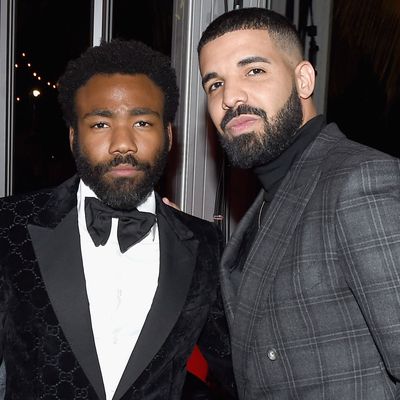
So far 2018 has been a banner year for Drake. Since February, Toronto’s leading performer has reigned over the singles charts: the uplift of “God’s Plan” carried it to first on the Hot 100 for nearly three months before Drake replaced it with the even peppier “Nice for What.” With the June release of the artist’s new album Scorpion looming, it seemed plausible that the streak would last for the majority of the year; in either case, there’s already no denying that pop music is a game Drake can win simply by choosing to play.
The sudden emergence of Childish Gambino’s “This Is America” has snapped Drake’s streak at 15 weeks, but even so, the breakneck success of Donald Glover’s conceptual trap number (and its music video especially) underlines the continuity of Drake’s formula for success more than it disrupts it. The ensemble cast of ad-lib suppliers on “This Is America” is a who’s who of contemporary southern trap, and it’s no accident that it overlaps heavily with Drake’s prime list of collaborators. Rising Memphis star BlocBoy JB charted for the first time in February off the strength of “Look Alive” and its Drake guest verse; his ad libs are only the slightest of his contributions to “This Is America,” where Glover’s dance routine features JB’s viral “shoot” dance prominently. Quavo, whose Migos have had a long and sometimes fraught history with Drake, is going on tour with Drake this year; Glover has cast the Migos in Atlanta as, well, the Migos in Atlanta. Young Thug’s four-dimensional warble has accompanied Drake no less than Gambino; the same goes for 21 Savage’s spartan contempt. (Rae Sremmurd’s Slim Jxmmi has never released a song with Drake, but Jxmmi and his brother Swae Lee did introduce Drake to their fans at an Amsterdam concert.)
Neither Glover nor Aubrey Graham are trap artists, but they’re both eager to position themselves in proximity to trap music. Glover’s mimicry of trap flows and vocabulary on “This Is America” echoes Drake’s own borrowings of lingo and triplets on If You’re Reading This It’s Too Late. It’s a recipe for commercial success predicated on a unique social position. As black middle-class artists with perfect fluency in (and complete acceptance from) white liberal mainstream culture, they’re ideally placed to mediate between paler neighborhoods’ fat pockets and the creative energies of the black South: witness the “God’s Plan” video, which lives off the images of Miami’s populations of color, or the production of “Nice for What,” with its evident debt to New Orleans bounce music. It’s true that the graphic violence and jagged tone of “This Is America” are far from any content Drake is ever likely to put out, and in that Glover’s track departs from Drake’s more inoffensive approach to courting his audience. But when it comes to channeling the South like an amplifier (and adding some distortion and profit for themselves in the process), there’s little difference between Drake and the artist who replaced him, this week, at the top of the charts. Drake will, no doubt, be back at number one soon enough; in the meantime his strategy for getting there hasn’t been dismantled by Donald Glover so much as it’s been upgraded.




